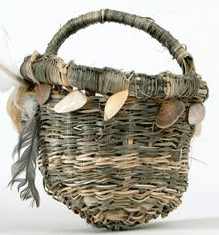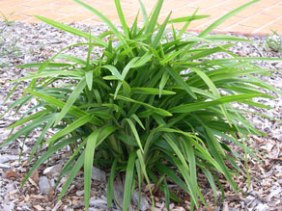Lomandra longifolia is an extremely popular, attractive and hardy tufted, strappy leaf plant native to eastern Australia. It has arching green leaf blades emerging from a central crown. The common species can range in height from 1 metre to 1.8 metres in ideal conditions. Flowers are dioecious ie male and female flowers grow on different plants. This is relevant as the female flowers are spikey and male flowers are not, enabling non spikey varieties to be selected for areas such as children’s play spaces or pedestrian pathways.
Many varieties and cultivars of Lomandra are available, with 8 propagated and sold here at Bluedale http://www.bluedale.com.au/our-selection/strappy-leaf-plants/lomandra-varieties . Bluedale’s Lomandra cultivars include ‘Shara’, ‘Tanika’, ‘Nyalla’, ‘Katrinus’, Katie Belles’ and ‘Tropic Belle’. Varieties that we propagate include Lomandra Longifolia and Lomandra hystrix. In the remainder of this article, this selection of 8 plants will be collectively referred to simply as Lomandra.
Listed below are Bluedale’s 10 top uses for Lomandra. These range from very practical applications, to the whimsical garden spaces many of us dream of. Useful links are available if more information is required.
Urban landscapes – Plants in public open spaces cop all kinds of mistreatment. They are regularly trampled or even pulled out and their growing environment is often less than ideal. Heat from pavements, buildings, roads etc combined with poor air quality and limited irrigation render the urban landscape one of the most difficult areas for growing plants. Lomandra has proven itself in the urban landscape for decades. Its toughness and adaptability to a wide variety of water and shade regimes, variety of soil type and tolerance of coastal aspects ensures Lomandra will continue to be found in most urban gardens spaces. Don’t underestimate their ability to look good – with a bit of creativity they can look amazing.
Road Corridors – Even more hostile than the urban landscape is the roadside environment. Non irrigated, north facing batters present the greatest challenge. Lomandra are proven performers on the verges and median strips of roads and freeways. With good soil preparation, correct pot sizes – viro-tubes or 140mm pots (see http://www.bluedale.com.au/about-us/latest-news/viro-tubes-or-potsnow-thats-question) and planting rates of 5 – 7 Viro-tubes per m2 – good results can be expected. Success can be improved by timing planting with seasons, irrigation (at least in early months) and adding an organic mulch.
Formal Gardens – Lomandra certainly have a place in the palette of the formal garden. Too often it is assumed that these plants belong in rustic bush garden settings only. Many Lomandra have the regular form so vital in a formal planting. Used well they can provide another dimension of foliage contrast. Mass plant under specimen trees or large shrubs for great formal effect. Use as borders for pathways, garden edges and retaining walls. Repeat the same cultivar or variety Lomandra throughout the garden to create connectivity. Use Lomandra as specimen plants themselves by drawing attention to their fantastic symmetry. They look great around water features too. For more ideas check out Bluedale’s article ‘Native Grasess can be Formal too’ http://www.bluedale.com.au/about-us/latest-news/native-grasses-can-be-formal-too
Playgrounds – Increasingly, children’s playgrounds include natural play spaces, offering a blend of natural areas, environmental features and plants. Such a landscape may include plants, boulders, water and sand, quiet social areas, interesting pathways, musical instruments as well as structured play equipment. Plant choice is critical for success when creating a natural play space. Lomandra with male only flowers (ie non spikey) are well suited to natural playspaces. Lomandra ‘Shara’, ‘Tanika’, ‘Nyalla’, ‘Katie Belles’ and ‘Tropicbelle’ all have non spikey flowers and strappy foliage that can be woven into baskets, platted into rope or generally wrestled in, jumped on and attacked! One established they will regenerate from their dense crown after damage. As seen in the ‘Bush Foods’ discussion below, Lomandra are also non-toxic. For more on using Lomanda in children’s play spaces refer to Bluedale’s article ‘Australian Ornamental Grasses for Children’s Play Spaces’ http://www.bluedale.com.au/about-us/latest-news/australian-ornamental-grasses-children-s-play-spaces
Revegetation – Lomandra is regularly used in the revegetation of degraded bushland. This is due to many factors, namely: large distribution in a variety of habitats throughout SE Australia; ease of propagation; and general hardiness. It shades out weeds, provides habitat for lizards, frogs and small animals and can self-seed given suitable conditions. When planting in remnant bushland, consideration should be given to using plants of local provenance – that is plants produced from seed growing in the local area with the aim of preserving genetic differences/variability. Provenance plants are not readily available at specialist nurseries, including Bluedale. We can supply them, however depending on season and species required, will require a lead time of 6 – 12 months. Alternatively both Lomandra longifolia and Lomandra hystrix can be grown in bushland areas using direct seeding techniques. Lomandra hystrix is useful in the revegetation of gallery rainforests where it dominates the understorey, typically with a Tristaniopsis laurina canopy above.
Containers – Narrow leaved Lomandra look fabulous in containers. ‘Shara’ (400mm tall), ‘Tanika’ (500mm tall) and ‘Nyalla’ (700mm tall) all have narrow, arching foliage and are well suited to planting in containers. They look good in single pots as ‘specimens’, however if planted in clusters of pots with perhaps the pot size or height being the only variable, the effect can be remarkable. The accompanying picture offers a great example of Lomandra ‘Tanika’ in containers.
Vertical Gardens. According to the Australian Bureau of statistics (1), the average site area of new houses in Australian capital cities has decreased over the last 11 years. As urban densities increase and garden areas shrink, vertical gardens are becoming a popular and successful way to grow plants for food or ornamental value. What a great way to screen an unpleasant view or dress up a bare wall! Vertical gardens are basically irrigated growing medium such as hydro-felt or rockwool, mounted on a board made of marine ply, plastic board or expanded propylene sheeting. Sometimes the water reticulated through the medium contains fertiliser. Lomandra is well suited to vertical gardens as it copes well with drying out, can survive sun and shade and has tough leaves that rarely wilt. For a great introduction to vertical gardening with Lomandra ’Tanika’ and Dianella visit http://www.youtube.com/watch?v=EkVj6QN0MCY
Bush Food Gardens. Australian Native Bush Food Gardens have so much to offer. Thousands of years of Aboriginal Heritage can come alive, quite literally in a bush food garden, with the Noosa & District Landcare Group listing an astounding 45 “Bushtucker” species in their local area alone (2). Lomandra longifolia is a vital inclusion in bush food gardens. It has leaf bases that are edible, with a pea-like flavour (3). Flowers are also edible – watch out for the spines! (3). The Noosa and District Landcare Group also list Lomandra hystrix as having the same bush food properties as longifolia (2). The Botanic Gardens Trust advises that plants should not be eaten unless purchased from a recognised bush food supplier. The tasting or testing of native plants is not recommended by the Botanic Gardens Trust (3).
Basket Weaving. The strappy leaves of Lomandra make it suitable for basket weaving. In children’s play spaces I have seen the construction of Lomandra baskets. Lomandra longifolia was (and in some places still is!) used by Aboriginal people for basket weaving and the construction of eel traps (4). Imagine a basket woven from the plants growing in your garden!
Labyrinth. Perhaps not the most conventional suggestion but surely a good one! Labyrinths, mazes and spirals have been used in gardens for centuries. According to the Labyrinth Society, the labyrinth itself is a single footpath used for personal, psychological and spiritual transformation. Labyrinths are thought to enhance right brain activity. And they look fantastic! Imagine a Lomandra labyrinth planted with turf in between the rows. Or a maze of with waist high Lomandra ‘walls’. Now that would be something………….
References
(1) Australian Bureau of Statistics article 8731.0 – Building Approvals, Australia, Jul 2004
(2) Native Species Recommended for Planting as Bushtucker Noosa and District Landcare Group http://www.noosalandcare.org/support_documentation/BUSHTUCKER.pdf
(3) The Royal Botanic Gardens and Domain Trust Website http://www.rbgsyd.nsw.gov.au/education/Resources/bush_foods
(4) Aboriginal Plant use in SE Australia Australian National Botanic Gardens https://www.anbg.gov.au/aborig.s.e.aust/lomandra-longifolia.html












 ‘Tanika’ is without a doubt, Bluedale’s best seller. We sell over 200,000 ‘Tanika’ annually. This is a reflection of the many positive attributes it brings to a wide variety of landscape situations. ‘Tanika’ retains its beautiful lush appearance in harsh environments such as urban landscapes. It follows that it looks magnificent when pampered in manicured residential gardens of the highest calibre.
‘Tanika’ is without a doubt, Bluedale’s best seller. We sell over 200,000 ‘Tanika’ annually. This is a reflection of the many positive attributes it brings to a wide variety of landscape situations. ‘Tanika’ retains its beautiful lush appearance in harsh environments such as urban landscapes. It follows that it looks magnificent when pampered in manicured residential gardens of the highest calibre. bine with hedging plants or use ‘Tanika’ to create a low hedge.
bine with hedging plants or use ‘Tanika’ to create a low hedge. Hardwood chip and non-organic gravel mulch have proven best in humid climates.
Hardwood chip and non-organic gravel mulch have proven best in humid climates.



 ves too difficult to sustain Little Jess, it is suitable to exposed seaside planting and coastal humidity. Little Jess can handle inland light frosts to -3oC. Minor leaf burn may occur when frosted, however this will be replaced by new growth in Spring.
ves too difficult to sustain Little Jess, it is suitable to exposed seaside planting and coastal humidity. Little Jess can handle inland light frosts to -3oC. Minor leaf burn may occur when frosted, however this will be replaced by new growth in Spring.



